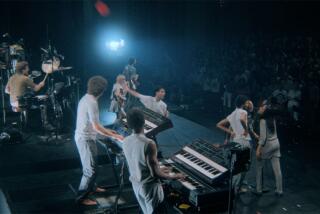MOVIE REVIEWS : ‘CURE IN ORANGE’: POP IN A ROMAN AMPHITHEATER
- Share via
Film makers keep trying to capture the excitement of rock concerts on film, and they keep failing. “The Cure in Orange” (at the AMC Century 14, Century City, and the AMC Mainplace in Santa Ana) pairs the intriguing English band, the Cure, with director Tim Pope, who’s overseen the group’s imaginative videos.
But instead of the creative sparks suggested by the collaboration, “In Orange” (Times-rated: Family) offers little more than a front-row seat at a Cure concert. That’s all right for a while, but even groups as imposing as the Band and Talking Heads did something special for “The Last Waltz” and “Stop Making Sense,” respectively, and the Cure is hardly in that league.
There is one extra: The concert was staged in a Roman amphitheater near Orange in the south of France. The massive pocked walls rising behind the band exert a strong, mysterious presence that plays effectively against the Cure’s romantic techno-rock, and some long, smoke-hazed shots of the audience suggest a revolutionary army waiting for battle. In the opening scene, the five musicians resemble Medieval trolls as they stalk the ruins on their way to the stage.
But Pope doesn’t do much with all this. He shoots the show straightforwardly, benefiting early from the rich light of an overcast late afternoon, pulling out new angles and approaches at regular intervals to keep up the interest. But the film inevitably drags.
The music is good enough (though the show predates the Cure’s best songs, from this year’s “Kiss Me, Kiss Me, Kiss Me” album), but the musicians are pretty drab as performers. Baby-faced leader Robert Smith, caught during his brief short-haired phase, has an innate magnetism, but remains sedate until the encore.
“In Orange” is a Cure fan’s delight, but it could have been more if Pope had tried to find a story somewhere in the show. One exchange of looks and conversation between Smith and bassist Simon Gallup over an apparent flub captures your attention because it shows some interaction, something going on beyond the playing. But there’s no effort to define the personalities of the players, nor to penetrate the band’s dynamic.
A better approach would have been to combine the best hour or so of performance with some behind-the-scenes footage. That might have been more predictable and conventional, but it also might have been interesting.
More to Read
Only good movies
Get the Indie Focus newsletter, Mark Olsen's weekly guide to the world of cinema.
You may occasionally receive promotional content from the Los Angeles Times.










